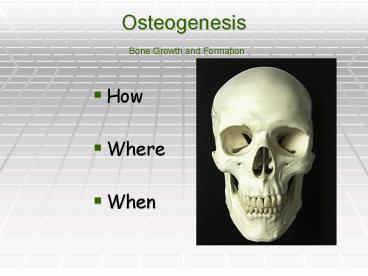Osteogenesis Bone Growth and Formation - PowerPoint PPT Presentation
1 / 17
Title: Osteogenesis Bone Growth and Formation
1
Osteogenesis Bone Growth and Formation
- How
- Where
- When
2
- The human skeleton consists of more than 200
bones of varying size, shape, and composition. - Is bone alive?
3
- YES, bone is a dynamic, living tissue
4
4 shapes
- long bones
- flat bones
- short bones
- irregular bones
5
- GROWTH
- growth rate and bone length factors
- genetics
- circulating hormones
- nutritional intake
- disease
6
- Bones grow longer from their ends
- Epiphyseal Growth Plate
7
- a - Epiphyseal plate made of hyaline cartilage
is responsible for long bone growth - Note The direction of growth is toward the
diaphysis (shaft of long bone).
8
- a Rows of dividing and then enlarging of
cartilage cells of the growth plate. - b Region of calcification (ossification) of
enlarged dead shells of cartilage cells to form
spongy bone - c Toward the epiphysis.
- d Toward the diaphysis
9
FORMATION or REMODELING
- Bone remodeling occurs continuously throughout
the lifetime, although the process slows with age
10
OUCH!!
- Breaks
- and
- Fractures
11
- 3 Cell Types
- Osteoblasts Osteocytes Osteoclasts
12
- Osteoblasts - involved in bone
formation - Osteoclasts - involved
in bone resorption.
13
- Osteoblasts that have been trapped in the mass
produced by other surroundings osteoblasts are
called Osteocytes. - Osteocytes maintain bones they play a role in
controlling the concentration of calcium and
phosphate - Osteoclasts secrete bone-reabsorbing enzymes,
which digest bone matrix.
14
(No Transcript)
15
- During childhood and the beginning of adulthood,
bone becomes larger, heavier and denser - Bone formation is then more important than bone
resorption
16
- When we are finished with puberty we stop growing
because our hormones cause all of the cartilage
within the epiphyseal disks to become ossified, - HOWEVER..
17
- Old bone is removed (resorption) and new bone is
created (formation) constantly.































